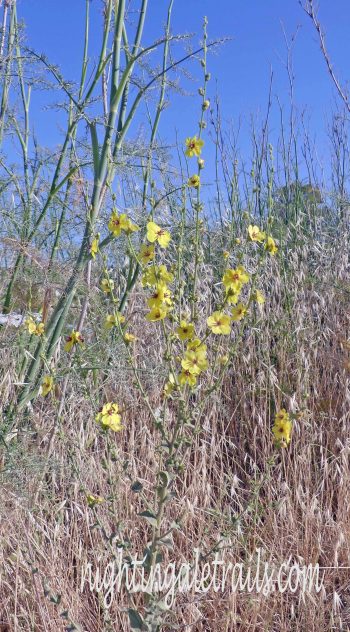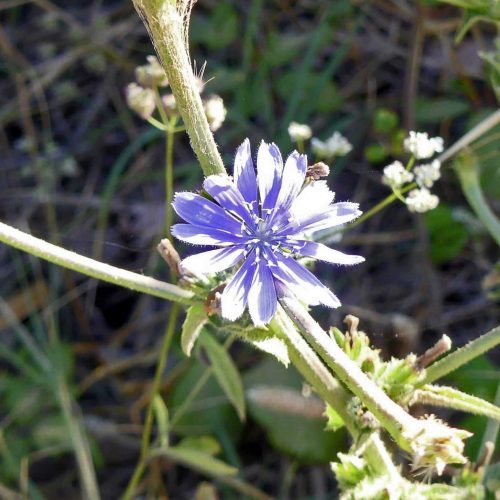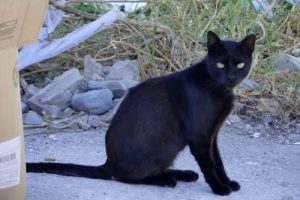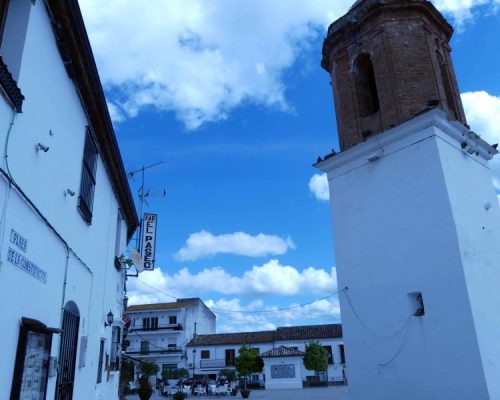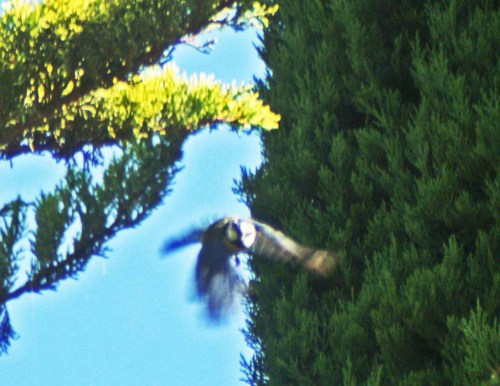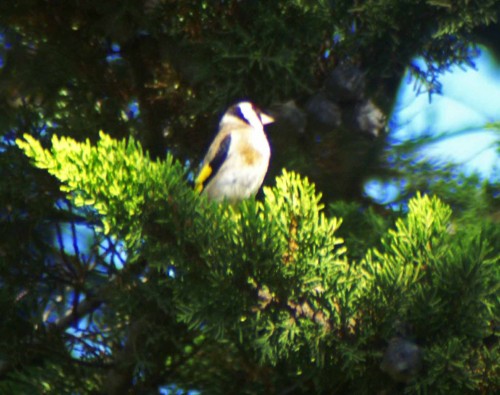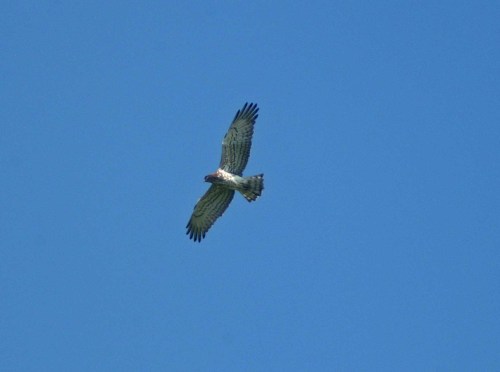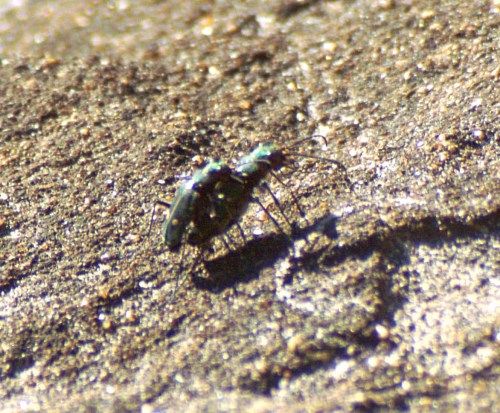June 10th – Marchionilla – Jimena de la Frontera
I can hardly believe it’s been five years since I last visited here during the month of June, so I couldn’t wait to get out and about to re-familiarise myself with the landscape and as much of the local fauna and flora that populates it as I could in the short time I was here.
07:35- At this time of year there are birds still nesting and although of course their mission to feed their young is a day-long one, still the best times of day to see most adults out and about is either in the cooler hours of the early mornings or the late evening. This morning I wanted to see and photograph wildflowers before the sun got too bright, but I was also questing after a bird that is very special to me – a Nightingale. It’s too late in the season to catch them singing, but out walking here a couple of evenings ago we’d heard what we thought were sounds of young ones in a nest, and we caught glimpses of an adult moving around in a dense shrub. A little later we had lovely sightings of another out in the open foraging along the edge of the track, so it’s likely it still had young in a nest too. I was hoping I may get lucky again this morning and at least catch sight of a parent trying to keep up with their offspring’s demands.
07:39 -I seem to be the only person out and about and am watched by Spotless Starlings perched up on an overhead cable soaking up some early sunshine.
 Bins for general rubbish and recycling are located at the bottom of the road opposite the venta. Regular deposits of food waste help support a whole family of jet-black green-eyed cats that spend much of their time in, around and beneath the bins, which venture out in hope each time someone approaches.
Bins for general rubbish and recycling are located at the bottom of the road opposite the venta. Regular deposits of food waste help support a whole family of jet-black green-eyed cats that spend much of their time in, around and beneath the bins, which venture out in hope each time someone approaches. They were guarding stacks of English-language paperbacks and DVDs on offer in front of the bins. I wondered what was in the plastic bag from Copenhagen, but resisted looking inside.
They were guarding stacks of English-language paperbacks and DVDs on offer in front of the bins. I wondered what was in the plastic bag from Copenhagen, but resisted looking inside.
Crossing to the other side of the main A405 road  a large signboard informs that this is the beginning, or end of the walking route given the name “Ruta Vega del Hozgarganta” ( in English, the Vega of the Hozgarganta Route). The route follows an ancient bridle path once used by muleteers and drovers and if you were to walk from here along its entire length, you would reach the southern end of Jimena de la Frontera. I was only planning to go as far as the river.
a large signboard informs that this is the beginning, or end of the walking route given the name “Ruta Vega del Hozgarganta” ( in English, the Vega of the Hozgarganta Route). The route follows an ancient bridle path once used by muleteers and drovers and if you were to walk from here along its entire length, you would reach the southern end of Jimena de la Frontera. I was only planning to go as far as the river.
The Spanish word vega is used to describe an area of low, flat, fertile ground that is generally at the edge of a river, which sums up this area perfectly. There are also lovely views across cultivated fields to the east and west to the hills that border the area. The short length of the track I was about to meander along is just about wide enough for two cars to pass and surfaced with some kind of aggregate that makes it hard but that turns easily to dust in dry weather. It runs between low-lying cultivated fields, passes an orange grove, gives access to a small number of farms and properties along its route and leads down to a ford crossing over the river Hozgarganta.
These trackside verges are pretty much left to their own devices and support an array of species of wildflowers. Although still early June, the summer heat was already intensifying and there’d been very little rainfall lately, so many plants were at the end of their flowering and setting, or had set seed, but there was still plenty left for me to see. One of the first to catch my eye as there’s quite a lot of it, was a white-flowered umbellifer. I often struggle with these as there are so many that look similar, but this one I do know- it’s Ammi majus, which has several common names, amongst them the intriguing False Bishop’s Weed.
Then there was a sunlit patch of Viper’s Bugloss, almost finished but with flowers still at the tips of its stems, sprawling out onto the dusty track.
Plants flowering at this time of year have to be particularly tough and be well equipped to survive and thrive in the hot dry conditions of early summer. This is the time that thistles dominate the roadsides and field edges, appearing in a variety of shapes and sizes, some are pretty spectacular and all command attention.
Scotch Thistles – Onopordum acanthium often tower above everything else, some easily reaching at least 2 – 2.5 metres in height. Those growing here were so tall I had to use a zoom lens to get close enough to see the flowers at the top.
My prize for the most eye-catching and dramatic thistle of them all must go to the Cardoon – Cynara cardunculus. Stunning, stately architectural plants they are beautiful in all their parts, although fearsomely spiny.
It’s not surprising they are widely cultivated as garden plants too.
By far the commonest and most abundant thistle, that for me is the emblem of early summer here in this region is most appropriately named Scolymus hispanicus, or in English, Spanish Thistle, Oyster Plant or as I know it a combination of the two, the Spanish Oyster Plant. In Spanish its common name is simply Tagarnina.
 This attractive tall golden-yellow flowered thistle grows abundantly in dry open places such as fields and most noticeably, on roadsides. It favours neutral or acid soils and is less common on limestone, but is very widespread and common throughout this area.
This attractive tall golden-yellow flowered thistle grows abundantly in dry open places such as fields and most noticeably, on roadsides. It favours neutral or acid soils and is less common on limestone, but is very widespread and common throughout this area.
Tagarnina is a sought-after foraged food plant in South-west Spain. When the first autumn rains fall, the plant reappears as a flat rosette of dark spiny leaves, which are cut. The leafy part is removed to leave the pale green midrib which is then used in stews and famously in omelettes, similarly to asparagus. I can verify that Tortilla de Tagarnina is delicious and served in many roadside ventas where the plant grows locally.
 The flowers of the Spanish Oyster plant are very attractive to insects too, particularly bees, which clamber over the anthers to access nectar, covering themselves in pollen on the way.
The flowers of the Spanish Oyster plant are very attractive to insects too, particularly bees, which clamber over the anthers to access nectar, covering themselves in pollen on the way.
Growing alongside the Spanish Oyster Plants in the above photograph is another stalwart of the late-flowering plants. It’s definitely a Mullein- or Verbascum, but I’m not completely sure of the specific species just now. This lovely tall branching plant, has delicate-looking pretty lemon-yellow flowers with violet-purple stamens at their centres. It’s quite widespread and common in this area.
Familiar as a garden plant grown both as a root vegetable and for its fragrant seeds, Fennel –Foeniculum vulgare is more than abundant here. It’s not currently flowering, but the smooth tough green stems and ferny foliage are unmistakeable. It’s tall too, easily reaching heights of up to 2 metres. I can never resist crushing a leaf to inhale its aniseed-like scent.
08.00 – It was already warming up and some of the local Griffon Vultures cruised slowly low overhead, possibly on the lookout for breakfast while waiting for thermals to build up and give them some lift to travel further away.
08:01 – I spot a wildflower that is a new species to me and one that I could easily have missed. It looks a bit like a delicate Knapweed, but has long spindly stems that don’t seem to be under any kind of control and go their own random ways. I discovered it’s called Crupina- Crupina crupinastrum and is a member of the thistle tribe.
08:04 -The track I am following curves off to the right now, dropping down in level as it approaches the river. As you can see the vegetation here is a blend of native shrubs and herbs backed by Eucalyptus trees and punctuated with an exotic Palm tree.
Here I found the pale lemon flowered Rabbit’s Bread Andryala integrifolia, in Spanish, Pan de Conejo. With its grey felted stems and leaves I always think this looks a soft, gentle kind of plant, but in reality it’s pretty tough, designed to deflect heat and preserve moisture.
There’s Wild Carrot too. On most plants the flowers are over and are either in the process of setting seed or have already done so, their umbels lifted and neatly closed together into an oval ‘cage’. I did find one or two still in flower though, a froth of tiny white blossoms surrounding the distinctive purple ones at their centre.
Raised banks clothed and topped with vegetation border the track going down to the river. It’s drying out now and covered with dust thrown up by passing cars. It’s hard to envisage that at times when rainfall has been heavy and prolonged the river level often rises and flows out to fill and cover the track up to here and beyond.
Beneath the layer of dust on the verge I realised there were the lovely bright blue flowers of Chicory peeping through.
08:07 An enormous, high bank of brambles mixed in with other scrubby vegetation reaches around and beyond the bend, providing great habitat for birds. Here they nest, forage and find cover when moving between more open spaces. I’d walked carefully around the bend as just ahead was where we’d watched the foraging Nightingale on the edge of the track. I knew there was little or no chance of seeing it out on the road now; it was brightly sunny and I’d already been passed by two cars, one from each direction, which had kicked up yet more dust as well as making noise.
08:11 – I saw a bird fly out from the bramble tangle and into a small Eucalyptus close by – definitely a Nightingale and with what appeared to be a largish insect in its beak! So it clearly does have a nest nearby, probably on the ground in the brambly vegetation, but quite rightly was waiting for me to go before going to it. I held my breath and grabbed a quick photograph, not great, but good enough to confirm my identification and show what the bird was doing, so I’m happy that we can now officially call this route a Nightingale Trail!
I carried on down towards the river, happy to have seen the lovely Nightingale and to know there are new members of their next generation concealed somewhere close by. They have noisy neighbours though – the raucous sounds of the frog chorus warming up reaches way beyond the riverbanks!
There’s another curve in the track before the river comes into view and again I walked carefully around, this time hoping to catch sight of the Grey Wagtail family we’d also seen the other evening. They were there – a parent and two young ones; the adult spotted me and took off quickly with one young one hot on its tail, but the other lingered a moment, just long enough for me to take its picture.
I wasn’t quick enough to catch the Grey Heron though and only managed to glimpse it as flew off upriver between the Eucalyptus trees.
The river level is low now, which may account for the urgency of the frogs’ calling. They may not have much time left to hold onto their watery territories.
08:17 – I’m not good at identifying frogs, especially as there’s so much variation in shading and patterning even within the same species, but I think this pleasantly plump one sunbathing on a rock may be a Marsh Frog?
I spotted another down in the water that may, or may not be a Painted Frog. I’d be more than happy for anyone knowing better to let me know! Whether I’m right or wrong, I love this image with the textures, patterns and shades of green of water and weedy algae stuff.
The track continues across the river here by way of what I suppose is a ford, nothing sophisticated, just a thick concrete slab that the water flows over, or not, depending how high its levels are. Sometimes it’s too deep to walk across, but this morning the water flowing across barely came to the top of the soles of my walking shoes. I took this picture from the other side to the way I was walking, so looking back the way I’d come with the river flowing from left to right.
Something about the damp layer of muddy sediment left by the receded water attracted a swarm of dozens of flies. As I stood taking the picture they landed all around me. They were actually quite attractive to look at closely, I just hoped they didn’t bite me.
The character of the surrounding habitat changes dramatically once you’ve crossed the river. Now it is dominated by a woodland that is predominantly Eucalyptus and on one side an understory of towering Giant Reeds.
High above my head a Damselfly is suspended from the leaf of a Giant Reed; it looked as though it may have just emerged.
08:29 – Into the shade of the trees and almost immediately a tiny bird flitting through low leafy branches caught my eye. My first thought was that it might be a Firecrest, based on its size and the way it moved, but I couldn’t catch sight of the top of its head, so couldn’t be sure. The one reasonable photograph I got doesn’t help much, but here it is anyway, in case anyone else has a clue.
Then came birds I had no problems identifying; a foraging family party of Blue Tits, this one looks a little bit odd, but it may be a young one in the process of growing its adult feathers.
There was a family of Great Tits too.
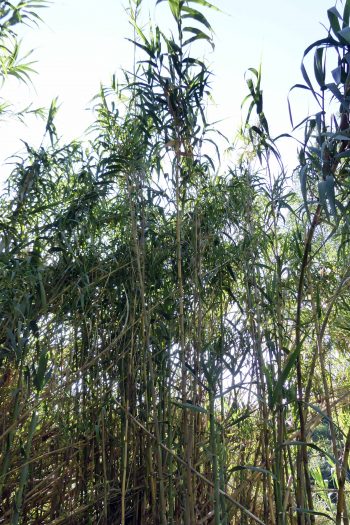 Then, to my absolute delight, a Golden Oriole began to sing. I crossed over to the other side of the track and stood in a cleared space amongst a stand of Giant Reeds to listen. These beautiful birds have an equally beautiful song, which is similar to that of a Blackbird but somehow richer and maybe louder too.
Then, to my absolute delight, a Golden Oriole began to sing. I crossed over to the other side of the track and stood in a cleared space amongst a stand of Giant Reeds to listen. These beautiful birds have an equally beautiful song, which is similar to that of a Blackbird but somehow richer and maybe louder too.
Some of those bird sounds were being made by Blackcaps that appeared in the reeds right next to me. There were four of them, so maybe another family: the one in my photograph looks like a young one.
08:38 – It’s warmed up considerably and the sky above the Eucalyptus trees is that almost-impossible shade of clear dark blue.
Re-crossing the river I stopped to look upstream in case the Heron may have come back. The water seems to be deeper on this side of the ford and it is still flowing at a good rate over the track, but its level is definitely lowering.
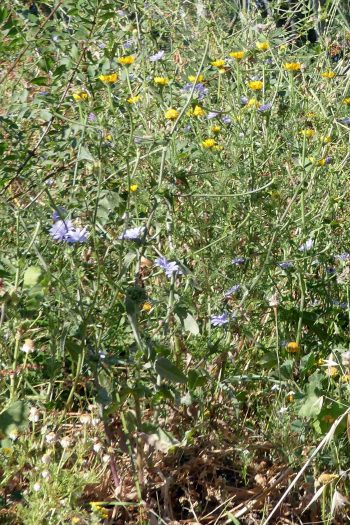 I stopped again just beyond the river to take a closer look at the vegetation on the side of the track. It’s an unruly tangle of Common Mallow, Chicory and Crown Daisies intertwined with various other stuff, too tricky to unravel and photograph clearly now. I was impressed by a nearby Crown Daisy though, that has not only managed to survive but to flower in a dry stony spot on the very edge of the track.
I stopped again just beyond the river to take a closer look at the vegetation on the side of the track. It’s an unruly tangle of Common Mallow, Chicory and Crown Daisies intertwined with various other stuff, too tricky to unravel and photograph clearly now. I was impressed by a nearby Crown Daisy though, that has not only managed to survive but to flower in a dry stony spot on the very edge of the track.
On a Chicory flower a cute little bee was taking nectar, she’s clearly been working hard, her pollen sacs are already bulging. We used to get these in the garden in Sotogrande and they seem to be quite common although never in any number, usually only one.
The view of the track going back – typical now of how introduced trees and plants have changed the landscape. I wonder what it looked like when the old drovers used to pass this way?
09:01 -I spot my first butterfly of the day, only a Small White, but it looked pretty as it balanced on the small cushiony head of a Crupina flower.
09:08 – In the big field at the top of the track there is activity. A tractor was towing a trailer loaded high with bales of hay. Along the edge of the field are bales of hay wrapped in white plastic, a common sight in the fields now. I think this is done for two reasons; dry hay is wrapped to preserve it that way and to cut out oxygen to stop it breaking down and wet or damp hay is wrapped to create silage for animal feed, which I’ve read described as a kind of pickling process for forage. It’s probably safe to say that anything cut now is going to be more than dry.
09:10 At the field entrance, it’s lovely to see wildflowers once strongly associated with cornfields all over Europe, including the British Isles; golden yellow Corn Marigold Crysanthemum segentum and scarlet poppies, Papaver rhoeas also sometimes known as Corn Poppies.
09:11 – A big grasshopper leapt into the middle of the road. Its long wings and stripy eyes suggest it an immature Egyptian Grasshopper. Although adults are big and brown, these grasshoppers start off tiny and green, then work their way through 5 instars before reaching adulthood.
09:14 – Back at the bins a ginger and white tabby is reclined on top of plastic bags and a member of the Black Cat family sits watching from the side-lines.Both gave me disdainful looks as though to ask “how dare you pass by without leaving anything for us?”
The piles of paperbacks and DVDs were gone. They’ll probably reappear at a future date, offered for €1 each at a weekend car boot sale.












